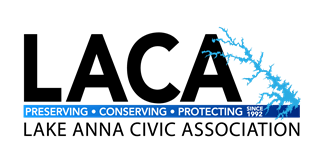- Home
- Programs
- Water Quality
- Cyanobacteria Mitigation & Remediation (CMR) Project
Cyanobacteria Mitigation & REMEDIATION (CMR) ProJECT
HAB at Lake Anna |
Kick the HAB
Help LACA Kick the HAB at Lake Anna by making a tax-deductible donation to the Kick the HAB fundraising effort.
127%
|
What is a HAB?
A harmful algal bloom (HAB) is an excessive growth of algae in aquatic environments, such as oceans, lakes, and rivers. While algae are a natural part of aquatic ecosystems and play a vital role in the food chain, certain conditions can lead to the rapid proliferation of specific types of algae, causing HABs. These blooms can have detrimental effects on the ecosystem, human health, and local economies.
HABs are often associated with the overabundance of certain species of algae, such as cyanobacteria (also known as blue-green algae) or dinoflagellates. These organisms can produce toxins, known as harmful algal toxins, which pose risks to other organisms, including fish, marine mammals, birds, and even humans.
The exact causes of HABs can vary, but they are often linked to a combination of factors, including nutrient pollution, warmer water temperatures, excessive sunlight, calm water conditions, and changes in water chemistry. Nutrient pollution, primarily from agricultural runoff, wastewater discharge, and fertilizer use, can lead to an excess of nutrients like nitrogen and phosphorus in the water. These nutrients act as fertilizers, promoting the growth of algae.
The impacts of HABs can be significant. The toxins produced by certain algae can contaminate seafood, making it unsafe for human consumption. Consuming tainted seafood can result in various health issues, including gastrointestinal problems, neurological effects, and even death in severe cases. HABs can also lead to the depletion of oxygen in the water, creating "dead zones" where marine life struggles to survive.
Furthermore, HABs can harm the economy and industries dependent on clean and healthy aquatic ecosystems. Coastal communities that rely on tourism, fishing, and recreation may experience economic losses due to HAB-related beach closures, declines in fish populations, and negative impacts on the overall aesthetic value of the environment.
Efforts to manage and mitigate HABs involve monitoring and early detection, reducing nutrient inputs into water bodies, and implementing appropriate water treatment techniques. Research and technology advancements are ongoing to develop effective strategies for predicting, preventing, and responding to HAB events in order to safeguard aquatic ecosystems and human well-being.
Project Overview
LACA has conducted water quality monitoring at Lake Anna in partnership with the Virginia Department of Environmental Quality (DEQ) since 2002. In addition, for the past four years we executed a more frequent and intensive cyanobacteria monitoring project focused on the problematic cyanobacteria issues found in the upper lake region tributaries. LACA volunteers spent the past four years investigating and researching various approaches, methodologies, and emerging technologies aimed at Harmful Algae Bloom (HAB) mitigation, remediation, and prevention. This investigation/research convinced us that the underlying causes of the HABs at Lake Anna are complex, deep-rooted, and difficult to precisely identify and that the solutions we decide to pursue need to be multi-faceted, and they will be expensive and will take a lot of effort over a long timeframe.
The data and information we generated from our research and analysis provides several potential paths forward to fight the cyanobacteria issues we have experienced over the past five years. Our action plan for Cyanobacteria Mitigation, Remediation and Prevention includes an extensive list of both short range and long range prospective actions.
LACA's lexicon for mitigation, remediation, and prevention actions are defined as follows:
- Mitigation: Capabilities, technologies, and techniques that are focused specifically on impacting the life-cycle of cyanobacteria cells. Algaecides and ultrasound techniques are LACA's primary mitigation interests. These techniques are intervention strategies with short-term effects that must be enacted almost continually during each recreational season. The desired effects of both algaecide and ultrasound technologies are observed quickly, often within 24 hours of initiation/application.
- Remediation: Capabilities, technologies, and techniques that are focused on reducing or eliminating energy sources that cyanobacteria cells feed on or consume. Phosphorous reduction techniques are LACA's primary remediation interests. Phosphorous reduction techniques are deterrence strategies with longer-term effects when applied in a layered approach to ensure internal and external phosphorous loads are controlled/eliminated. The desired effects of phosphorous reductions technologies are observed relatively quickly, often within weeks of initiation/application.
- Prevention: Capabilities, technologies, and techniques that are focused on returning the lake and its watershed to an ecologically balanced state without the use of mitigation or remediation techniques. Wetland restoration/creation in and around the Lake Anna watershed is a great example of a preventative strategy. Studies have strongly suggested that prevention techniques are costly (hundreds of millions of dollars) and it takes a long time to achieve the desired effects. For these reasons, LACA's project plans do not include any prevention approaches.
